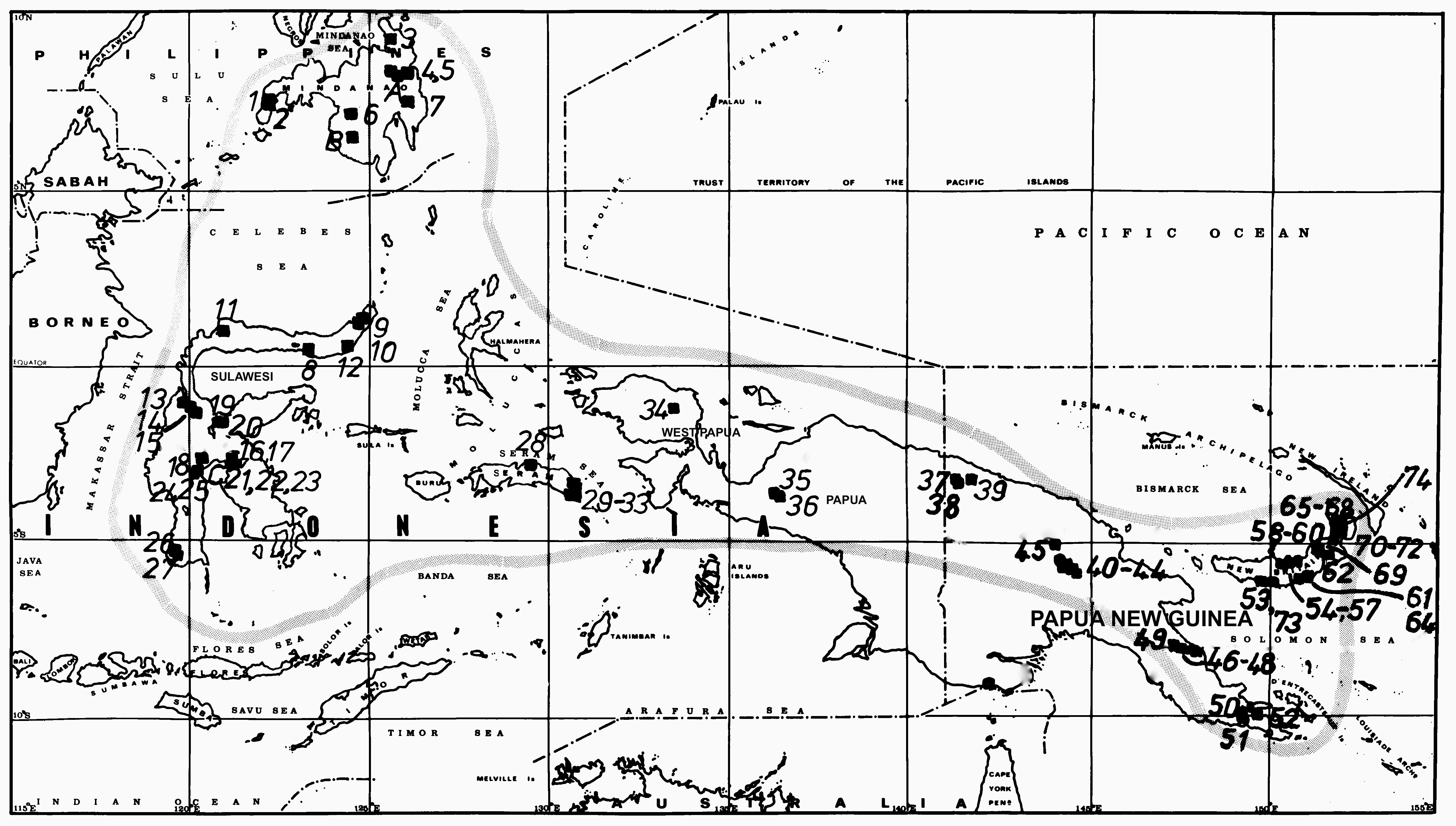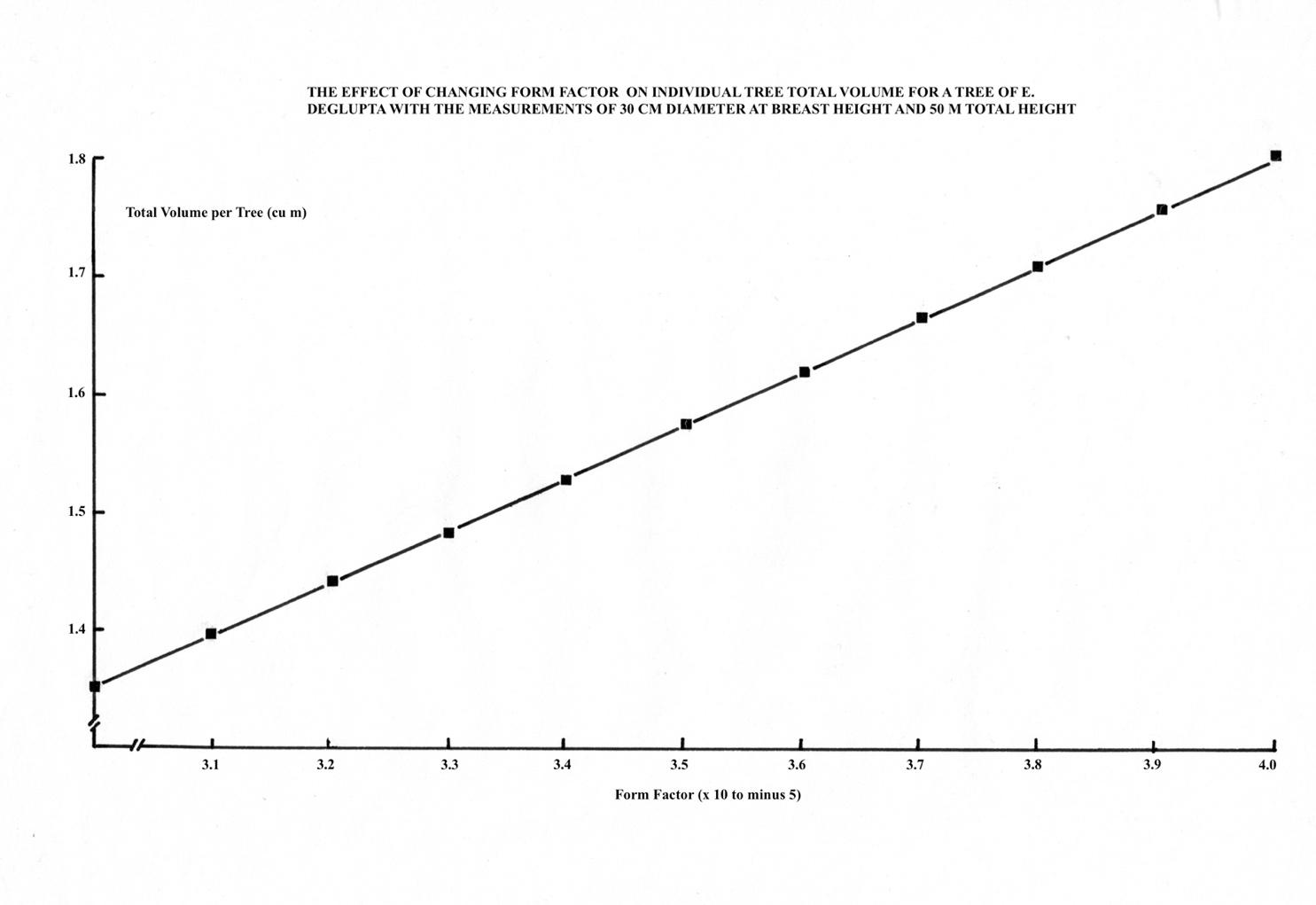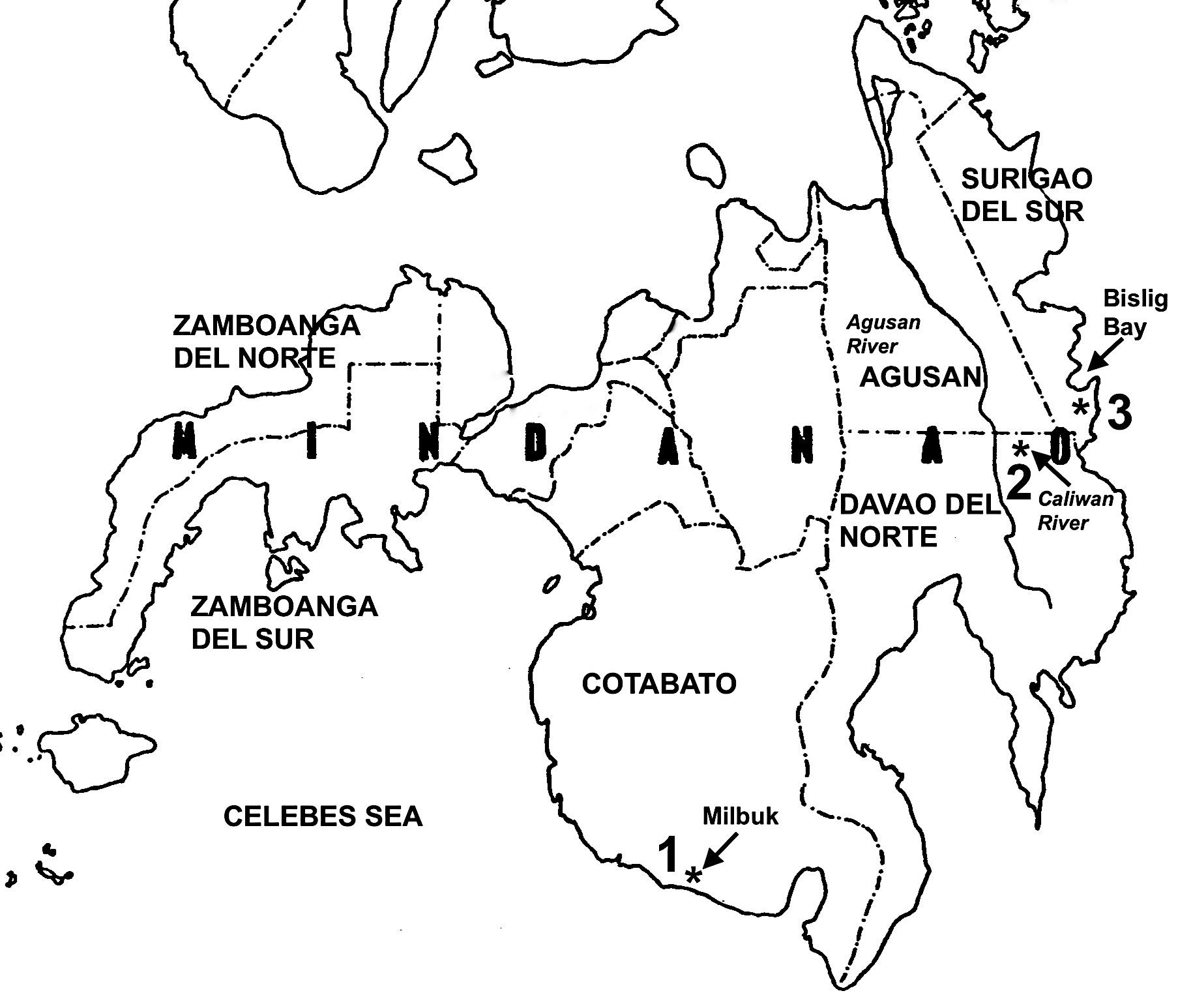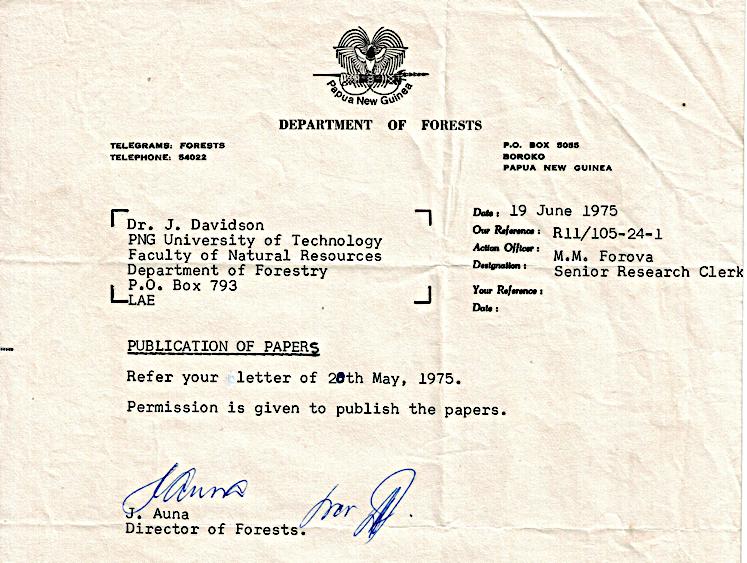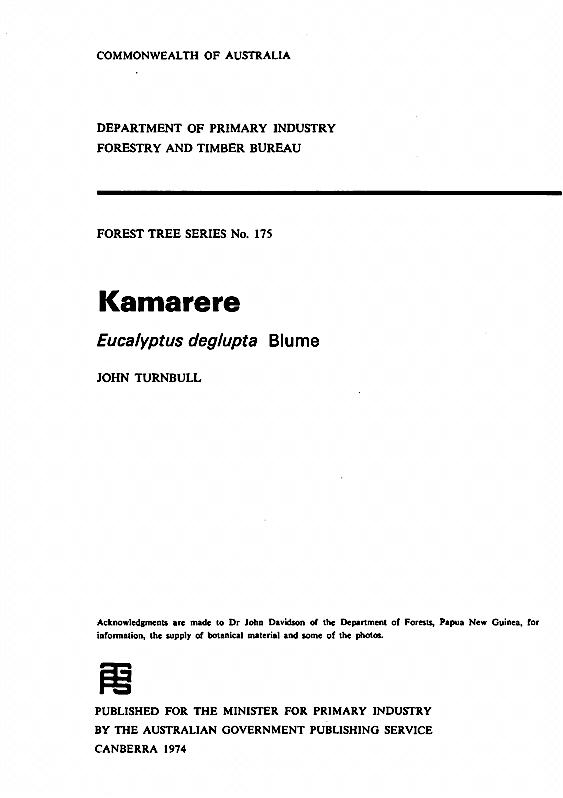
18 minute read
Provenance seed collection of E. deglupta in Irian Jaya, Indonesia, 3–17 June 1975
from PNGAF MAG ISSUE # 9 B-5B4D3 Dr John Davidson Accompaniment "RAINBOW EUCALYPT MAN" Part 6 of 8 parts
by rbmccarthy


Advertisement
E. deglupta in Central Celebes. Top left: Cohorts of different ages on the banks of the Lindu River, Palolo Plain (location no. 12 on map). Top right: Trees on the banks of the Tampak River (location 27). Left: Stand on the bank of the Tomini River (location 25). Below: Young regeneration in the foreground and larger trees behind on the bank of the Sopou River (near location 12). (Photographs by C Cossalter 1975.)

Provenance seed collection of E. deglupta in Irian Jaya, Indonesia, 3–17 June 1975
The second major seed collecting activity agreed by the IUFRO meeting in Nairobi was an expedition to Irian Jaya
24
, Indonesia. This was undertaken from 3 – 17 June 1975. The distribution of E. deglupta had been broadly mapped,
25
though its distribution in Irian Jaya was less well known because of the inaccessibility of the province’s interior. The only hard evidence available comprised Eyma’s specimen 5360 collected from Bogesiga, Wissel Lakes area in 1939, Zeick’s herbarium specimens including BW3286 collected near Kebo north of the Wissel Lakes in 1960 and Van Royen and Sleumer’s specimen
24 In 2002 Irian Jaya was granted “special autonomy”, the Province was divided into two east-west, and the names Papua and West Papua allowed respectively. Enarotali and Lake Paniai are in Papua Province at the western end of the central highlands (Maoke Mountains) (see map next page). 25 Davidson, J. 1973 Conservation of the gene resources of tropical Eucalyptus deglupta Blume. Tropical Forestry Research Note SR 12, Department of Forests, PNG; and Turnbull, J.W. 1974 Kamarere: Eucalyptus deglupta Blume. Forest Tree Series, No. 175, Forestry and Timber Bureau, Australian Government Publishing Service, Canberra.
7946 collected in 1961 from Mt Nettoti in the headwaters of the Andjai and Wekari Rivers on the Vogelkop Peninsula at about 1,800 m elevation (illustrated earlier in this account).
The collection party consisted of D. Boland, FRI Canberra, Australia, myself (then seconded to the Papua New Guinea University of Technology) and N. Howcroft, Research Station, Department of Forests, Bulolo, PNG, J. Dali, Forest Research Institute, Bogor and S. Hutagaol, Department of Forestry, Jayapura, Indonesia. Airfares and travelling allowances for party members were paid for from an FAO fund for seed collection granted to FRI Canberra. It was previously agreed that all seed collected would be divided half each between the Indonesian and the Papua New Guinea/Australian participants.
An unsuccessful attempt was made to determine the precise time to make collections before departure. For this reason, the timing of E. deglupta collections was predicted from known collection times in Papua New Guinea.
Boland, Howcroft and myself assembled with our gear at the airport in Lae to catch the scheduled Air New Guinea flight to Madang on the afternoon of 2 June 1975. We suffered an immediate setback in that facing bad weather, the DC3 would not be able to uplift our accompanying cargo. This meant we would not be in a position to join the flight to Vanimo and Jayapura the following day. A hasty visit was made by Nev Howcroft to the Regional Forest Office in Lae where a Cessna 402 charter was immediately arranged to take the party and the essential equipment to Madang that evening.
We left Lae in the dark, travelling just off the coast towards Madang in deteriorating weather. Visibility was nil. We were buffeted by rain and severe turbulence. Lightning flashed in the clouds. The pilot’s

instrument flying was dead on and we broke out of the cloud at the last minute perfectly aligned with the runway lights of the Madang airport.
The next morning was fine and the party successfully joined the scheduled flight to Vanimo, and after a brief stopover continued on to Jayapura on the morning of 3 June 1975. The collection team met our Indonesian counterparts in Jayapura. They were J. Dali, Forest Research Institute, Bogor and S. Hutagaol, Department of Forestry, Jayapura, Indonesia. Some time was expended to obtain travel permits for the next leg which was to Kota Biak on the south coast of Biak,
26 a small island in
Cenderawasih Bay of the north coast of Papua.


Kota Biak. Top left: from left, Nev Howcroft, Doug Boland and Junus Dali. Top right: Hotel accommodation. Bottom left and right: Town views.

More visits to the authorities in Biak were required to obtain travel permits for our onward journey. We divided into two groups at Biak.27 Boland, Davidson and Dali went to Enarotali via Nabire to make collections of E. deglupta and Howcroft and Hutagaol to Manokwari with the object of proceeding into the Kebar area to make collections of E. deglupta and Araucaria cunninghamii. Because of unforeseen transport difficulties, the latter party was unable to proceed into the Kebar valley.

26 Now called Pulau Supiori. 27 This account is derived from and expands on: Boland D J, Davidson J and Howcroft N 1977 Eucalyptus deglupta Blume and Araucaria cunninghamii Lambert provenance seed collections in Irian Jaya, Indonesia, 3 – 17 June 1975. Forest Genetic Resources Information 6:315.


Nabire in 1975. Left: Airport and environs. Right: DPAD Kabupaten Paniai Office. More administrative details: additional police permits and travel authorizations were required to be obtained here for onwards travel to Enarotali.

Enarotali and environs in 1975. Altitude of Enarotali airstrip at 1,750 m and the Lake surface at 1,742 m.




The local Mission at Enarotali operated a sawmill. Pit sawing was used for primary breakdown and a small circular saw bench was used for resawing. Logs were floated across the Lake or brought in to a jetty using a small barge.
Our accommodation in Enarotali.

The Boland team hired nine carriers at Enarotali to transport camping gear, tools, equipment, plant presses, a chainsaw, food and fuel. The forester at Enarotali and two members of the local police accompanied the team. An outboard motorboat was hired from the local Catholic Mission to transport the team from Enarotali, across the Lake to Little Kebo (see map). On the way it was noted many of the 200 or more blunt-ended canoes without outriggers (“proas”) seen were hewn from solid logs of E. deglupta that would have been up to one metre in diameter.


Left: The team moves out towards the Lake with a policeman in the bow. Another policeman in the stern caused concern by firing his pistol over our heads at cormorants (shags) perched on driftwood while rocking the boat in the process which made his aim erratic! Right: A typical blunt-ended canoe hewn out of a solid log of E. deglupta used by the local villagers for transport and fishing on the Lake.
When the motorboat could proceed no further the team disembarked with their gear in the shallow swampy area on the northeast shore of Lake Paniai near Little Kebo. Doug Boland is the person in the white shirt.
Left: Our arrival in Giteuto Village. Right: Our base camp area. Most of the pig fences were split E. deglupta and Casuarina sp. Many of the latter nearby were pruned of their branches all or almost all of their length for fuel, and some kind of rotation was practised for this, with some stems still intact or regrown, and some only partially harvested.

The team walked from Little Kebo through Kebo to Giteuto northwest of Kebo where a base camp largely constructed from local bush materials was set up on the bank of the Koebejo River. On the way two tree climbers were recruited from Kebo to assist the collection team.




Top: Our base camp in Giteuto Village. Sleeping places off the ground for Doug Boland and myself and cooking facilities. Part of the food we had carried in comprised Australian army one-day ration packs that we had acquired in Madang. Bottom: A constant stream of curious locals came to visit. (The colour balance of some of these photographs was affected by the high humidity that the exposed films were kept in, before they were sent to Kodak in Melbourne for processing after our return to PNG.)




People of Giteuto Village. The man with the axe and others like him were used by the team to supplement the efforts made with chainsaws to fell the huge E. deglupta trees we encountered.
Four patrols (numbered 1 – 4 on the map) were made from Giteuto to inspect E. deglupta (local name “djewo”) and collect herbarium specimens and seed. The first was made to the steep hillsides immediately northeast of the base camp. The second was made to the west bank and adjacent hillsides of the Koebejo River. The third patrol was made into the headwaters of the Koebejo River from where an unsuccessful attempt was made to cross the high ground above 2,300 m elevation with the intention to descend into the Erome River valley. The fourth patrol was made to Kederebutu.

Sketch map showing the routes taken by the collection party across Lake Paniai and into the hills north of the Lake. Enarotali is considered to be the only colonial town built in the interior of New Guinea by the Dutch.


Left: On the way into the forest, we came across this felled E. deglupta which was destined to be made into a canoe. Right: Large E. deglupta trees. These had been climbed and branches harvested to provide material for pig fences. Note that in the tree in the background one of the severed branches has “hung up”. Steel axes were used by the tribespeople for these tasks and represented a prodigious expenditure of human energy. Crowns of E. deglupta near Kebo were large with heavy branches that were swollen at the junction with the trunk. As the crowns of these adult trees emerged10–15 m above the surrounding canopy, it was possible to recognise the species from a great distance on land and also from the air because of its characteristic crown shape, branching habit, open foliage and lighter coloured leaves.
In the Koebejo River valley E. deglupta usually occurred as scattered veteran individuals or sometimes in small clumps of up to seven trees. One large stand of about 20 trees was observed in a gully behind a ridge on the eastern side of a tributary of the Koebejo River, known locally as Gummi River. Very few trees were seen in riverain positions and most were situated high up on the steep hillsides and on ridges. Several E. deglupta stumps and logs from recently felled trees were seen on hillsides facing the Lake. The local villagers valued the timber of E. deglupta for several uses. The most important was for the building of the canoes already mentioned but the species was also in demand for pig-fence stakes, bridges over small streams and firewood. Some of the short span bridges were constructed from retired
canoes. The bark of E. deglupta was sometimes used as a roofing material. The survival of the remaining trees was probably associated with their position on hillsides facing away from the Lake and being difficult for the villagers to fell and extract logs for canoes or drag roughly hewn canoes at first uphill before being able to take advantage of the downhill slope towards the Lake. It was estimated that altogether 400 standing trees were seen. Regeneration of E. deglupta was entirely lacking in the areas visited. The base of the trunks of many of the large trees were enlarged and knotty, a feature not seen elsewhere with E. deglupta, and here may indicate fortuitous origin through coppice from stumps of trees harvested by tribal people perhaps hundreds of years ago. The main associate species were Castanopsis, Palaquium, Cryptocarya, Garcinia, Myristica and Eugenia spp.
The soils around the Wissel Lakes were derived mostly from limestone parent material. In the Koebejo River valley and near Little Kebo, the soils were derived from sandstone and siltstone parent materials. E. deglupta was found growing only on these latter soils. Between Kebo and Little Kebo there was a small area of soils apparently volcanic in origin. The altitudinal range of the species was approximately 1,700 – 2,000 m. Rainfall averaged 2,500 – 3,500 mm per annum. Because of altitude the nights were very cool.
Over a period of five days, two trees were felled with great difficulty because of their size. Wood samples were taken from these two trees. Herbarium specimens and fruits were collected from these two trees and specimens and fruits from another five trees were obtained by climbing. The climbers used a technique of climbing a nearby smaller tree then crossing over to the collection tree, bypassing the smooth broad part of the trunk of the target tree. Sometimes a vine bridge would be made between the two trees. A vine loop was also placed loosely around the climber’s ankles to provide frictional support while climbing. Seed bearing branches were severed by machete. The seed crop was generally poor with approximately 160 g of seed collected from four trees (the two felled and two of those climbed). Several trees were carrying dry open fruits. Apparently in this location most of the seed had fallen in a peak period about one to two months before the team arrived so scheduling of the mission based on typical seed collection times in PNG proved to be unhelpful. Nevertheless, there were many individual trees with inflorescences at widely different stages of development. This suggests that the period in which seed can be collected is lengthened although the number of individuals from which seed can be collected outside of the peak period is fewer. Collection by whole tree felling is unsatisfactory because fruits scatter when the crown hits the ground. Good aeration of the fruits after collection is also essential in humid conditions to avoid seed deterioration through fungal growth.
The maximum size of trees was 50–70 m in height and 160–200 cm diameter. Clear boles were up to 30 – 40 m. However, on average they were somewhat smaller in size than the very large veterans encountered by me in New Britain. The forest type in which E. deglupta was found was in a mixed broadleaved forest having a stocking and volume per unit area of not less than that found in typical tropical lowland forest elsewhere in New Guinea. In this primary forest no natural regeneration of the light-loving E. deglupta was found. Two young saplings were located on the bank of a creek in a place where mature trees had been felled.


The trunk of these trees was usually straight, or slightly twisted, and buttressed at the base. The diameter of the trees and the substantial buttresses presented a challenge to fell them with our chainsaw with only a 24-inch cutter bar and limited fuel and oil supplies. Left: scaffolding erected to be able to cut above the buttresses. Above: It required both chainsaw and axes to fell this tree. Below left: This tree was mostly sound to the centre with only some evidence of incipient decay near the pith, in marked contrast to veterans of similar size in New Britain that typically had very large pipes and only 20–30 cm of solid wood on the outside. Below right: Substantial wood sample collected for transport back to PNG.


Herbarium specimens collected:
Near Koebejo River, Wissel Lakes, Irian Jaya, altitude 1,850m, 10 June 1975, Davidson 1010 (WL1), Diameter 130 cm, Height 50 m. Among single dominants on steep slopes. Veteran trees with long raking branches, in fruit (LAE, FRI).
Near Koebejo River, Wissel Lakes, Irian Jaya, altitude 1,825m, 11 June 1975, Davidson 1011 (WL2), Diameter above buttress 125 cm, Height 50 m. On steep slope, north of Kebo Mission Station. Top broken out. On shallow yellow-brown soil over sandstone (LAE, FRI).
Near Kebo, on slope near Koebejo River, Wissel Lakes, Irian Jaya, altitude 1,850 m, 12 June 1975, Davidson 1012 (WL3), Specimens with dry capsules collected (LAE, FRI).
Near Kebo, on the bank of the Koebejo River, Wissel Lakes, Irian Jaya, altitude 1,750 m, 12 June 1975, Davidson 1013 (WL4), Near stream bed, Diameter 55 cm, Height 35 m. In bud (LAE, FRI)
Near Kedergboetoe, Wissel Lakes, Irian Jaya, altitude 1,750 m, 12 June 1975, Davidson 1014 (WL5), Large tree, twisted trunk, foot of the trunk with a stocking of reddish-brown fibrous bark, strips of bark falling off and piling up at the base of the tree (LAE, FRI)
Near Koebejo River, Wissel Lakes, Irian Jaya, altitude 1,850 m, 13 June 1975, Davidson 1015 (WL6), On steep slope, Diameter 140 cm, Height 65 m, flowers and fruit present (LAE, FRI)
Koebejo Valley, near Kebo, Wissel Lakes, Irian Jaya, altitude 1,750 m, 14 June 1975, Davidson 1016 (WL7), on steep slope away from river, Diameter 75 cm, Height 35 m, clear bole 20 m. Main associates Castanopsis, Palaquium, Cryptocarya, Garcinia and Eugenia species, (LAE, FRI)
Upon return to Enarotali unconfirmed reports were received from villagers that E. deglupta also occurred in the Pugo River valley south of Enarotali and in the Koto River valley near Obano at the western extremity of the Lake. A motorboat trip from Enarotali up the Pugo River and some walking along the shoreline and inland in the vicinity of Kaitadi failed to locate any E. deglupta.
The collecting teams re-grouped in Kota Biak and all material collected was divided two ways, one lot for Bogor, Indonesia the other for PNG/FRI. Boland, Davidson and Howcroft returned to Lae PNG via Jayapura and Vanimo. Unfortunately, the viability of seed taken into PNG was extremely low apparently because of zealous quarantine treatment with methyl bromide fumigation of all specimens, seed, clothing, boots and equipment at the Herbarium in Lae. Seed taken from Biak to Bogor was believed to be viable. At Bulolo a few viable seeds were obtained by shaking them from the drying fruits on herbarium specimens and 11 trees were eventually raised.
28
The density of the wood samples of the large trees ranged from 600 – 900 kg/m3
. At this locality in a cool moist climate, the dense (for E. deglupta) heartwood high in extractives seemed to impart a degree of durability in the air (for house and bridge construction), in the ground (sharpened stakes for pig fences) and in the water (canoes).
E. deglupta fruits from near the Wissel Lakes were morphologically different from other known
28According to Neville Howcroft, three of these trees still remained near Bulolo in 2018.
provenances. They were larger and the fruit valves were not prominently exserted. The ovary was inferior and not half-inferior as is the general case for E. deglupta. The number of valves per fruit was mostly four, but occasionally five and six, or more. Other provenances usually have three or four valves. The staminal ring was deciduous, but this was not uncommon in E. deglupta elsewhere. The pedicels were longer and more markedly quadrangular than seen in other provenances.
The shape of adult leaves from the Wissel Lakes area was also different from other provenances. Leaves were from 5 to 11 cm (average 8 cm) in length and from 3 to 7.5 cm (average 4.5 cm) in width. The basal angle of the leaf lamina was markedly obtuse, similar to the Waria River (PNG) provenance (type locality of E. schlechteri Diels) and very different from Mindanao (Philippines) and New Britain (PNG) specimens which normally had more acute basal angles. Some of the trees had pronounced drip tips, others not so.



Top left: Near mature capsules typical of the E. deglupta at the Wissel Lakes shown close to natural size. The capsules were larger and the ovaries inferior (depressed almost completely below the rim) giving a hemispherical appearance rather than the near globular appearance of smaller capsules at a similar stage in other provenances. Top right: After dehiscence and seed shed, capsules here show from four to six loculi, with the valves not prominently exserted. Left: Diagrams comparing a capsule from Wissel Lakes (on the left side) with a capsule of the Keravat provenance of E. deglupta. Here both examples are four-valved and the prominence of the open valve scales in the Keravat example is marked. (Drawings by N Howcroft, Bulolo, 1975; about 5x.)

